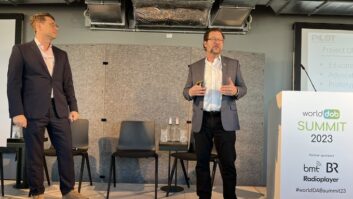Ten themes were discussed in detail at the July 5 RadioDNS Automotive and Broadcaster Workshop.�A few weeks after the event, RadioDNS�Project Director�Nick Piggott�addressed several questions about the concerns addressed during the workshop.
�
Doug Irwin: �How can broadcasters help manufacturers enable a good quality experience when switching between broadcast and streaming? What are the barriers to making this work?
Nick Piggot: �The driver experience of switching between broadcast and streaming could lie on a line between entirely seamless and intrusively clunky. We agreed that an intrusively clunky experience wasn’t what anyone wanted, but also acknowledged that aspiring for a truly seamless blend would be technically expensive and difficult to maintain, for both manufacturers and broadcasters. We also talked about how the driver needs to know and acknowledge that they’re being switching to streaming, as it has implications for data usage / costs.
The manufacturers asked the broadcasters to give them the best possible stream to work with, which to them was one of equitable audio quality (and loudness), with a reasonable and constant latency, and without additional advertising (such as pre-roll and ad-break extensions). The broadcasters need to think if their current streams meet those criteria, or if they want to create new, private, streams specifically to support switching to streaming in the car.
Irwin: Why are manufacturers attracted to proprietary systems for solving their problems, and why are broadcasters wary of them?
Piggot: �We acknowledged that both manufacturers and broadcasters routinely buy in technology from external suppliers that use proprietary interfaces for data exchange. There was agreement that the benefit of open standards was interoperability; that any member of the ecosystem could swap out their systems without impacting on the other members of the ecosystem. For instance, a broadcaster could change their technology provider for processing their playout data, or a manufacturer could have multiple providers of systems to process hybrid radio data depending on target device.
Interoperability of hybrid radio needs to be at an equivalent level of the interoperability of broadcast radio. Everyone should buy-in systems that implement and respect the interoperability boundaries, so there’s reassurance the entire (and complex) global radio ecosystem will work correctly.
Irwin:�What content should broadcasters produce and how should manufacturers show it to drivers? How can content reflect what�s on-air, including editorial and commercial messages?
Piggot:��We talked about the motivations for broadcasters to invest in new content and systems, which are very heavily influenced by perceived competitive threat. If extended radio functionality (like text and images) is hard for drivers to access, few of them use it, and so it has minimal competitive value, which is reflected by the broadcasters� reluctance to invest in it. The manufacturers acknowledged that, and say that they are moving towards putting real-time content right to the front of the radio experience, which will create a bigger differentiation between those stations who do it well and those who don’t do it at all.
Aside from concerns about content being too distracting by updating too frequently, there was no specific concern expressed by manufacturers about what content could be displayed to the driver, which leaves the door open for novel commercialization models.
Irwin: �What are the differing views on how drivers should find radio stations, and what meta-data is required to power different navigation models?
Piggot:��What surfaced during the workshop was a real demand from manufacturers for good quality meta-data from broadcasters about their content. As the lists of available content in the car grow, manufacturers are having to implement recommendation and searching alongside traditional dial lists (although they said the Station List concept was still the main navigation model). Broadcasters who provide better data will be surfaced more frequently when drivers search for things to listen to.
It was agreed that IP was the best way to deliver all this data to the car, with an acknowledgement that broadcast can be used as a low quality carrier for cars that aren’t connected to IP.
�
�
There was much more to this meeting, and you learn more in detail here. Also, continue reading Digital Radio Update for more news and information regarding RadioDNS and the concept of hybrid radio.
�










